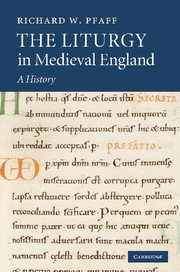Book contents
- Frontmatter
- Contents
- Preface
- Sigla and editorial conventions
- Bibliographical abbreviations
- Nicknames for manuscripts frequently referred to
- 1 Introduction
- Excursus: on sources
- 2 Early Anglo-Saxon England: a partly traceable story
- Excursus: on the terms Gregorian and Gelasian as used here
- 3 Later Anglo-Saxon: liturgy for England
- 4 The Norman Conquest: cross fertilizations
- Excursus: on method in the comparison of liturgical texts
- 5 Monastic liturgy, 1100–1215
- Excursus: on ascription of liturgical books to specific churches
- 6 Benedictine liturgy after 1215
- 7 Other monastic orders
- 8 The non-monastic religious orders: canons regular
- 9 The non-monastic religious orders: friars
- Excursus: on liturgical books from female religious houses
- 10 Old Sarum: the beginnings of Sarum Use
- 11 New Sarum and the spread of Sarum Use
- 12 Exeter: the fullness of secular liturgy
- 13 Southern England: final Sarum Use
- 14 Regional Uses and local variety
- 15 Towards the end of the story
- Index of Manuscripts
- Index of Saints
- General Index
6 - Benedictine liturgy after 1215
Published online by Cambridge University Press: 20 March 2010
- Frontmatter
- Contents
- Preface
- Sigla and editorial conventions
- Bibliographical abbreviations
- Nicknames for manuscripts frequently referred to
- 1 Introduction
- Excursus: on sources
- 2 Early Anglo-Saxon England: a partly traceable story
- Excursus: on the terms Gregorian and Gelasian as used here
- 3 Later Anglo-Saxon: liturgy for England
- 4 The Norman Conquest: cross fertilizations
- Excursus: on method in the comparison of liturgical texts
- 5 Monastic liturgy, 1100–1215
- Excursus: on ascription of liturgical books to specific churches
- 6 Benedictine liturgy after 1215
- 7 Other monastic orders
- 8 The non-monastic religious orders: canons regular
- 9 The non-monastic religious orders: friars
- Excursus: on liturgical books from female religious houses
- 10 Old Sarum: the beginnings of Sarum Use
- 11 New Sarum and the spread of Sarum Use
- 12 Exeter: the fullness of secular liturgy
- 13 Southern England: final Sarum Use
- 14 Regional Uses and local variety
- 15 Towards the end of the story
- Index of Manuscripts
- Index of Saints
- General Index
Summary
The title of this chapter should not mislead the reader into thinking that after 1215 (or possibly before) there was an entity clearly identifiable as the liturgy of the Benedictines. The specifically liturgical provisions of the Rule of St Benedict are almost entirely concerned with the daily office, and worship which was in accord with those provisions can fairly be called Benedictine worship. Agreement with the Rule was the single criterion that mattered, although, as has been frequently noticed in previous chapters, considerable accretions grew around the office in connection with various influential monastic regimes: for example, Cluny (incomparably the most important; see p. 243 for a discrete section on worship in Cluniac houses), Fleury, the Winchester of the Regularis concordia. But there was never a mechanism for absolute liturgical uniformity, as was to come to be the case with some later bodies, above all the friars, spearheaded by the Dominicans. Even after 1215, Benedictine abbeys remained for the most part autonomous, liturgically as well as in other ways.
In November 1215 Pope Innocent III's Fourth Lateran Council promulgated two canons that in effect brought about the establishment or, better, the regularization, of something like an Order of St Benedict. Canon 12 mandated General Chapters, to be held at least every three years, for all those living according to any religious rule; and canon 13 forbade the establishment of new religious orders, specifically using the term ordo.
- Type
- Chapter
- Information
- The Liturgy in Medieval EnglandA History, pp. 200 - 242Publisher: Cambridge University PressPrint publication year: 2009



